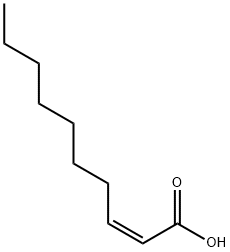(Z)-2-decanoic acid
- CAS NO.:15790-91-7
- Empirical Formula: C10H18O2
- Molecular Weight: 170.25
- MDL number: MFCD20543109
- SAFETY DATA SHEET (SDS)
- Update Date: 2024-11-19 20:33:22

What is (Z)-2-decanoic acid?
The Uses of (Z)-2-decanoic acid
cis-2-Decenoic Acid is an organic compound which appears to be functionally and structurally related to the class of short-chain fatty acid signaling molecules such as diffusible signal factor, which act as cell-to-cell communication molecules in bacteria and fungi.
The Uses of (Z)-2-decanoic acid
cis-2-Decenoic acid may be used to study its cytotoxic effect on the human HepG2 cell line. It has also been used to study its synergistic anti-spirochetal effect.
What are the applications of Application
cis-2-Decenoic acid is an unsaturated short chain fatty acid
Definition
ChEBI: Cis-2-decenoic acid is a 2-decenoic acid having its double bond in the cis configuration.
Biochem/physiol Actions
cis-2-Decenoic acid is a fatty acid messenger (signaling molecule) produced by Pseudomonas aeruginosa. It possesses anti-biofilm property and converts most of the cells to planktonic (free-swimming) phenotype. cis-2-Decenoic acid retains the susceptibility of the bacteria towards antimicrobial agents. It does not exhibit any toxicity towards human cells and thus, might be used for treating biofilm-associated infections. cis-2-Decenoic acid is considered active even in nano-molar ranges. It mediates the transition of dormant P. aeruginosa and Escherichia coli to their biologically active state without affecting the number of cells. cis-2-Decenoic acid is effective against E. coli and Klebsiella pneumoniae mixed-species biofilms when used along with antimicrobial agents.
Properties of (Z)-2-decanoic acid
| Boiling point: | 278.6±9.0 °C(Predicted) |
| Density | 0.936 |
| storage temp. | -20°C |
| solubility | DMSO : 250 mg/mL (1468.43 mM; Need ultrasonic) |
| form | Powder |
| pka | 4.63±0.25(Predicted) |
| color | Colorless to light yellow |
| BRN | 1721990 |
Safety information for (Z)-2-decanoic acid
| Signal word | Warning |
| Pictogram(s) |
 Exclamation Mark Irritant GHS07 |
| GHS Hazard Statements |
H315:Skin corrosion/irritation H319:Serious eye damage/eye irritation H412:Hazardous to the aquatic environment, long-term hazard |
| Precautionary Statement Codes |
P264:Wash hands thoroughly after handling. P264:Wash skin thouroughly after handling. P273:Avoid release to the environment. P280:Wear protective gloves/protective clothing/eye protection/face protection. P302+P352:IF ON SKIN: wash with plenty of soap and water. P305+P351+P338:IF IN EYES: Rinse cautiously with water for several minutes. Remove contact lenses, if present and easy to do. Continuerinsing. P332+P313:IF SKIN irritation occurs: Get medical advice/attention. |
Computed Descriptors for (Z)-2-decanoic acid
New Products
4-Fluorophenylacetic acid 4-Methylphenylacetic acid N-Boc-D-alaninol N-BOC-D/L-ALANINOL Tert-butyl bis(2-chloroethyl)carbamate 3-Morpholino-1-(4-nitrophenyl)-5,6-dihydropyridin- 2(1H)-one Furan-2,5-Dicarboxylic Acid Tropic acid S-2-CHLORO PROPIONIC ACID ETHYL ISOCYANOACETATE 2-Bromo-1,3-Bis(Dimethylamino)Trimethinium Hexafluorophosphate (6-METHYL-[1,3]DITHIOLO[4,5-b]QUINOXALIN-2-ONE INDAZOLE-3-CARBOXYLIC ACID 4-IODO BENZOIC ACID (2-Hydroxyphenyl)acetonitrile 4-Bromopyrazole 5,6-Dimethoxyindanone 2-(Cyanocyclohexyl)acetic acid 4-methoxy-3,5-dinitropyridine 2-aminopropyl benzoate hydrochloride 1-(4-(aminomethyl)benzyl)urea hydrochloride diethyl 2-(2-((tertbutoxycarbonyl)amino) ethyl)malonate tert-butyl 4- (ureidomethyl)benzylcarbamate Ethyl-2-chloro((4-methoxyphenyl)hydrazono)acetateRelated products of tetrahydrofuran
You may like
-
 cis-2-Decenoic acid CAS 15790-91-7View Details
cis-2-Decenoic acid CAS 15790-91-7View Details
15790-91-7 -
 2033-24-1 98%View Details
2033-24-1 98%View Details
2033-24-1 -
 1975-50-4 98%View Details
1975-50-4 98%View Details
1975-50-4 -
 2-HYDROXY BENZYL ALCOHOL 98%View Details
2-HYDROXY BENZYL ALCOHOL 98%View Details
90-01-7 -
 2-Chloro-1,3-Bis(Dimethylamino)Trimethinium Hexafluorophosphate 221615-75-4 98%View Details
2-Chloro-1,3-Bis(Dimethylamino)Trimethinium Hexafluorophosphate 221615-75-4 98%View Details
221615-75-4 -
 61397-56-6 CIS BROMO BENZOATE 98%View Details
61397-56-6 CIS BROMO BENZOATE 98%View Details
61397-56-6 -
 14714-50-2 (2-Hydroxyphenyl)acetonitrile 98+View Details
14714-50-2 (2-Hydroxyphenyl)acetonitrile 98+View Details
14714-50-2 -
 118753-70-1 98+View Details
118753-70-1 98+View Details
118753-70-1

